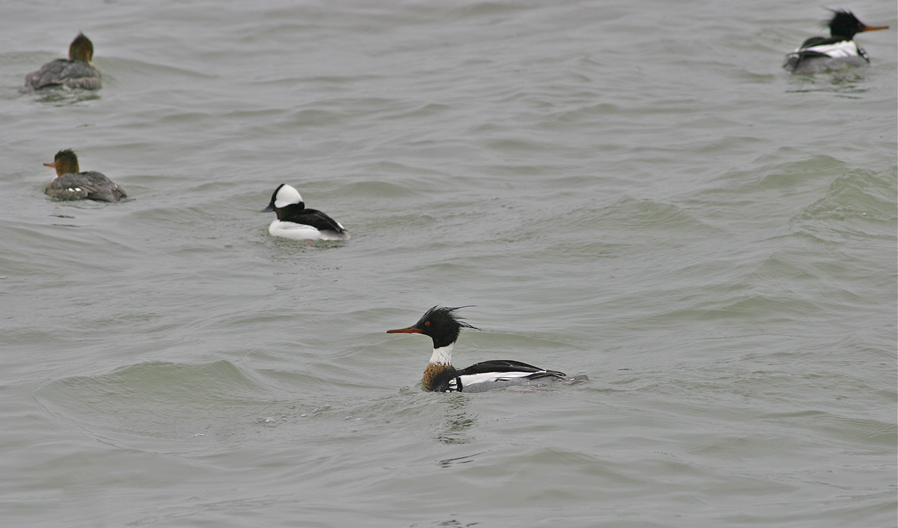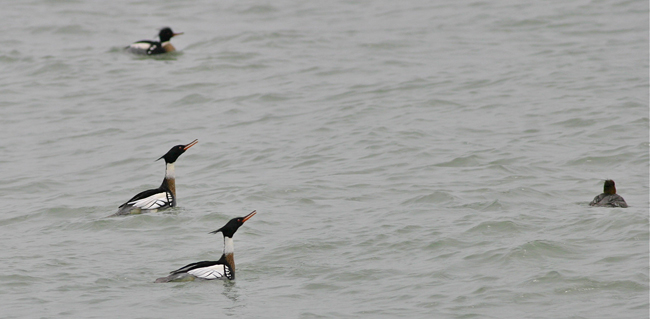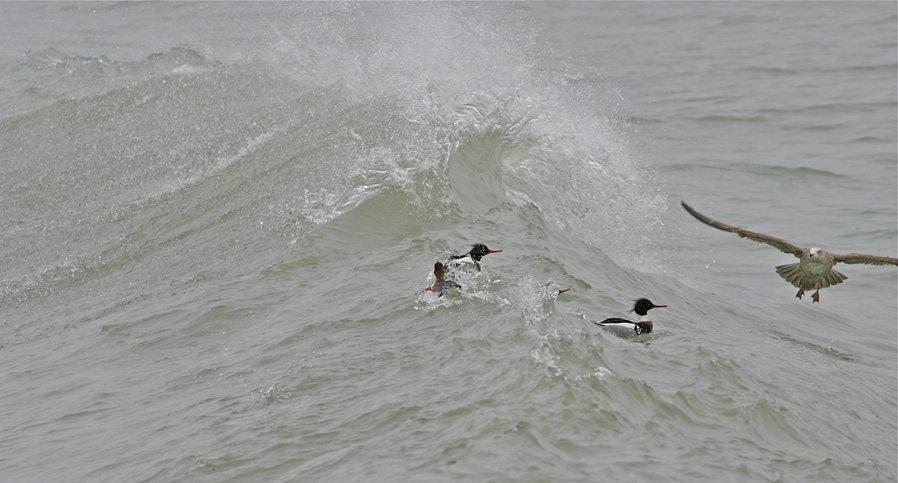A male red-breasted mergansers (Mergus serrator) at Ashbridge’s Bay this week. A male bufflehead (Bucephala albeola) is behind and to the left of the merganser. The crest of the males in this species appears as a double spike, unlike the spike of the common merganser, which appears to be a single spike. © BCP 2011
Another huge thrill this week at the bay. Went down to check on the ducks on what seemed (at first) like a relatively calm day, wind-wise. So I was surprised to hear the roar of the waves before I actually saw them.
I had actually intended to have a brisk walk out to the end of the peninsula (aka the peanut) to get a wee bit of exercise before work. But the waves captivated me and I didn’t get as far as I intended. There were huge swells out on the open water of the lake, and when the waves came in they were crashing into the shore with huge force, sending gigantic sprays of water up onto the rocks nearly onto the path. I was careful to keep my camera equipment out of the spray raining down.
Looking out to the swells and crashing waves, where there were dozens and dozens of ducks congregated — buffies, longtails and scaups. I saw some ducks that looked at first like common mergansers. But a closer inspection with my binoculars revealed that they were actually red-breasted mergansers. Hugely exciting for me as it was the first time I had ever seen these Arctic ducks at our bay.
Fascinating avian fact: Red-breasted mergansers are VERY fast ducks, able to reach speeds of 130 kilometres per hour. (Source: Waterfowl of Eastern North American, by Chris G. Early; Firefly Books, 2005.) Wiki actually says that people claim these ducks to be the fastest bird in level flight. (Although Wiki goes on to say that the white-throated needletail may be faster, with recorded speeds of up to 170 kilometres per hour.)
Fastest or not, these spikey-haired amusing-looking mergansers are certainly among the most beautiful of all the water birds. There were dozens of pairs of them, as well as many common (American) mergansers, and all were busily a’courting. I couldn’t take my eyes off them.
-
Two male red-breasted mergansers begins their courting ritual by lifting their heads and beaks upward. The behaviour is called the salute-curtsy. © BCP 2011
-
In the picture to the left, you can see two males at the beginning of their courtship ritual, a dance repeated hundreds, if not thousands, of times a day. The ritual is called the salute-curtsy: the males point their beaks upwards, then dip their breast forward deeply into the water, while their back end rises out of the water. The males do this displaying behaviour in small groups for the benefit of the females nearby.
The mergansers were displaying an equally fascinating behaviour regarding feeding, using the crashing waves as a kind of shortcut to dinner. They floated out on the heavy swells, then, at the exact moment the wave would crest and fall over, the ducks dove into the centre of the watery maelstrom — presumably grabbing their prey — likely fish or crustaceans this time of year, underwater. Their bright orangey-red beaks have sharply serrated edges to assist them in capturing their prey, hence their species name, serrator.
You can sort of see the behaviour I’m talking about in the picture below, which I snapped just as the wave was breaking. In the centre of the photo you can just see the orange beak of one of the males diving under as the weight of the breaking water is about to fall on him.
Hope these migrants are still around when I get back to the bay on my next outing. © BCP 2011






no comments